1995 GMC SIERRA window
[x] Cancel search: windowPage 151 of 488
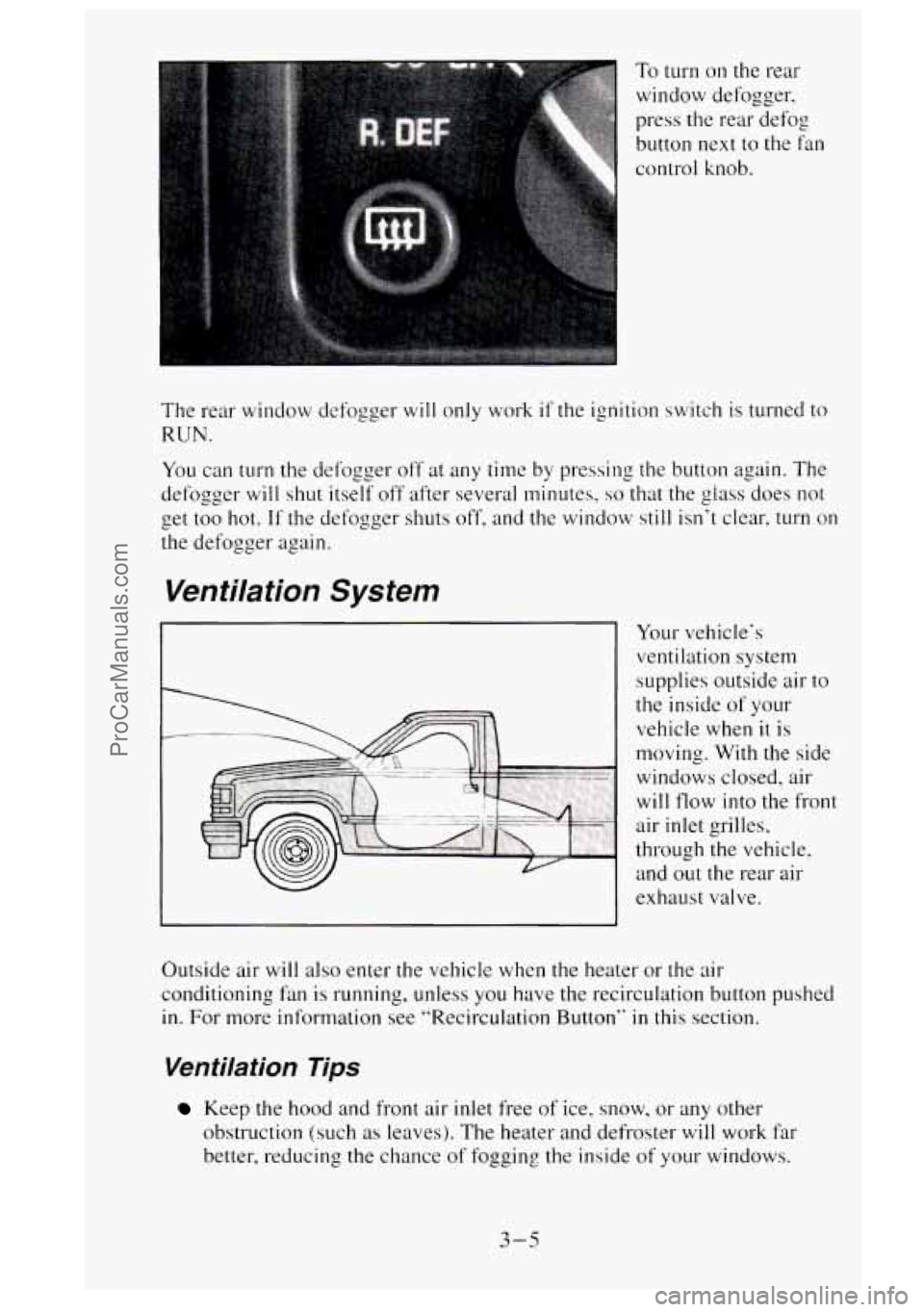
To turn on the rear
window defogger,
press the rear defog
button
next to the fan
control knob.
‘he rear window defogger
will only work if the ignition switch is turned to
:UN.
‘ou can turn the defogger off at any time by pressing the button again. The
efogger
will shut itself off after several minutes, so that the glass does not
et too hot.
If the defogger shuts off, and the window still isn’t clear, turn on
le defogger again.
Ventilation System
Your vehicle‘s
ventilation system
supplies outside air
to
the inside of your
vehicle when
it is
moving. With the side
windows closed, air
will flow into the front
air inlet grilles,
through the vehicle, and out the rear air
exhaust valve.
Outside air
will also enter the vehicle when the heater or the air
conditioning fan is running, unless you have the recirculation button pushed
in.
For more information see “Recirculation Button’‘ in this section.
Ventilation Tips
Keep the hood and front air inlet free of ice, snow, or any other
obstruction (such
as leaves). The heater and defroster will work far
better, reducing the chance
of fogging the inside of your windows.
3-5
ProCarManuals.com
Page 152 of 488
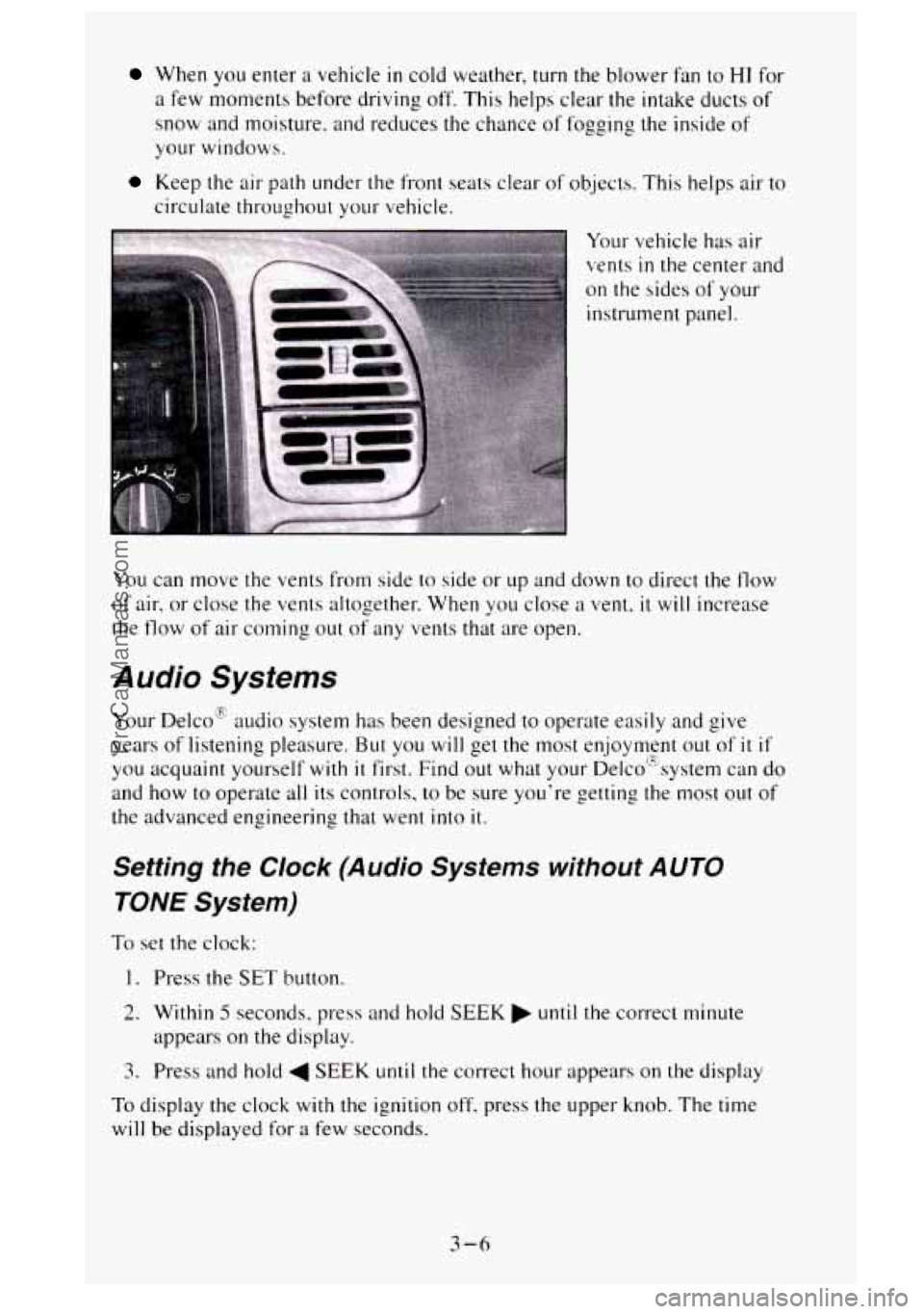
When you enter a vehicle in cold weather, turn the blower fan to HI for
a few moments before driving off. This helps clear the intake ducts of
snow and moisture. and reduces the chance of fogging the inside. of
your windows.
Keep the air path under the front seats clear of objects. This helps air to
circulate throughout your vehicle.
Your vehicle has air
vents
in the center a1
on the sides of your
instrument panel. nd
You can move the vents from side to side or
up and down to direct the flow
of air. or close the vents altogether. When you close a vent, it will increase
the
flow of' air corning out of any vents that are open.
Audio Systems
Your Delco'E audio system has been designed to operate easily and give
years of listening pleasure.
But you will get the most enjoyment out of it if
you acquaint yourself with it first. Find out what your De1co"system can do
and how to operate all its controls, to be sure you're getting the most
out of
the advanced engineering that went into it.
Setting the Clock (Audio Systems without AUTO
TONE System)
To set the clock:
1. Press the SET button.
2. Within 5 seconds, press and hold SEEK until the correct minute
appears
on the display.
3. Press and hold 4 SEEK until the correct hour appears on the display
To display the clock with the ignition off, press the upper knob. The time
will
be displayed for a few seconds.
3-6
ProCarManuals.com
Page 202 of 488
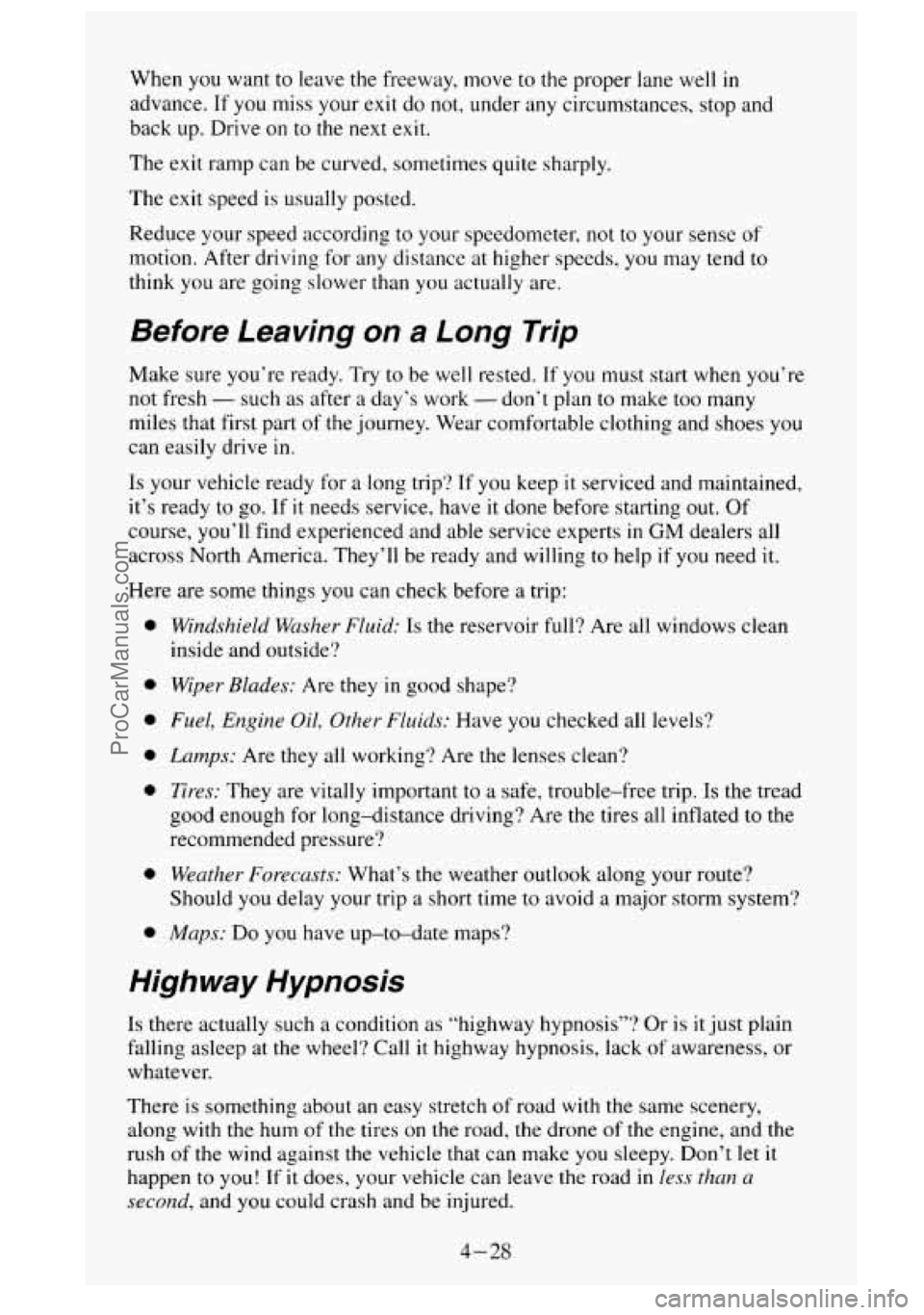
When you want to leave the freeway, move to the proper lane well in
advance. If
you miss your exit do not, under any circumstances, stop and
back up. Drive on
to the next exit.
The exit ramp can be curved, sometimes quite sharply.
The
exit speed is usually posted.
Reduce your speed according to your speedometer, not to your sense
of
motion. After driving for any distance at higher speeds, you may tend to
think you are going slower than you actually are.
Before Leaving on a Long Trip
Make sure you’re ready. Try to be well rested. If you must start when you’re
not fresh
- such as after a day’s work - don’t plan to make too many
miles that first part
of the journey. Wear comfortable clothing and shoes you
can easily drive
in.
Is your vehicle ready for a long trip‘? If you keep it serviced and maintained,
it’s ready to go.
If it needs service, have it done before starting out. Of
course, you’ll find experienced and able service experts
in GM dealers all
across North America. They’ll be ready and willing to help if you need it.
Here are some things you can check before a trip:
0
0
0
0
0
a
0
Windshield Washer Fluid: Is the reservoir full? Are all windows clean
inside and outside?
Wiper Blades: Are they in good shape?
FueZ, Engine Oil, Other Fluids: Have you checked all levels?
Lamps: Are they all working? Are the lenses clean?
Tires: They are vitally important to a safe, trouble-free trip. Is the tread
good enough for long-distance driving? Are
the tires all inflated to the
recommended pressure?
Weather Forecasts: What’s the weather outlook along your route?
Should
you delay your trip a short time to avoid a major storm system?
Maps: Do you have up-to-date maps?
Highway Hypnosis
Is there actually such a condition as “highway hypnosis”? Or is it just plain
falling asleep at the wheel? Call it highway hypnosis, lack of awareness, or
whatever.
There
is something about an easy stretch of road with the same scenery,
along with the
hum of the tires on the road, the drone of the engine, and the
rush
of the wind against the vehicle that can make you sleepy. Don’t let it
happen
to you! If it does, your vehicle can leave the road in less than a
second, and you could crash and be injured.
4-28
ProCarManuals.com
Page 207 of 488
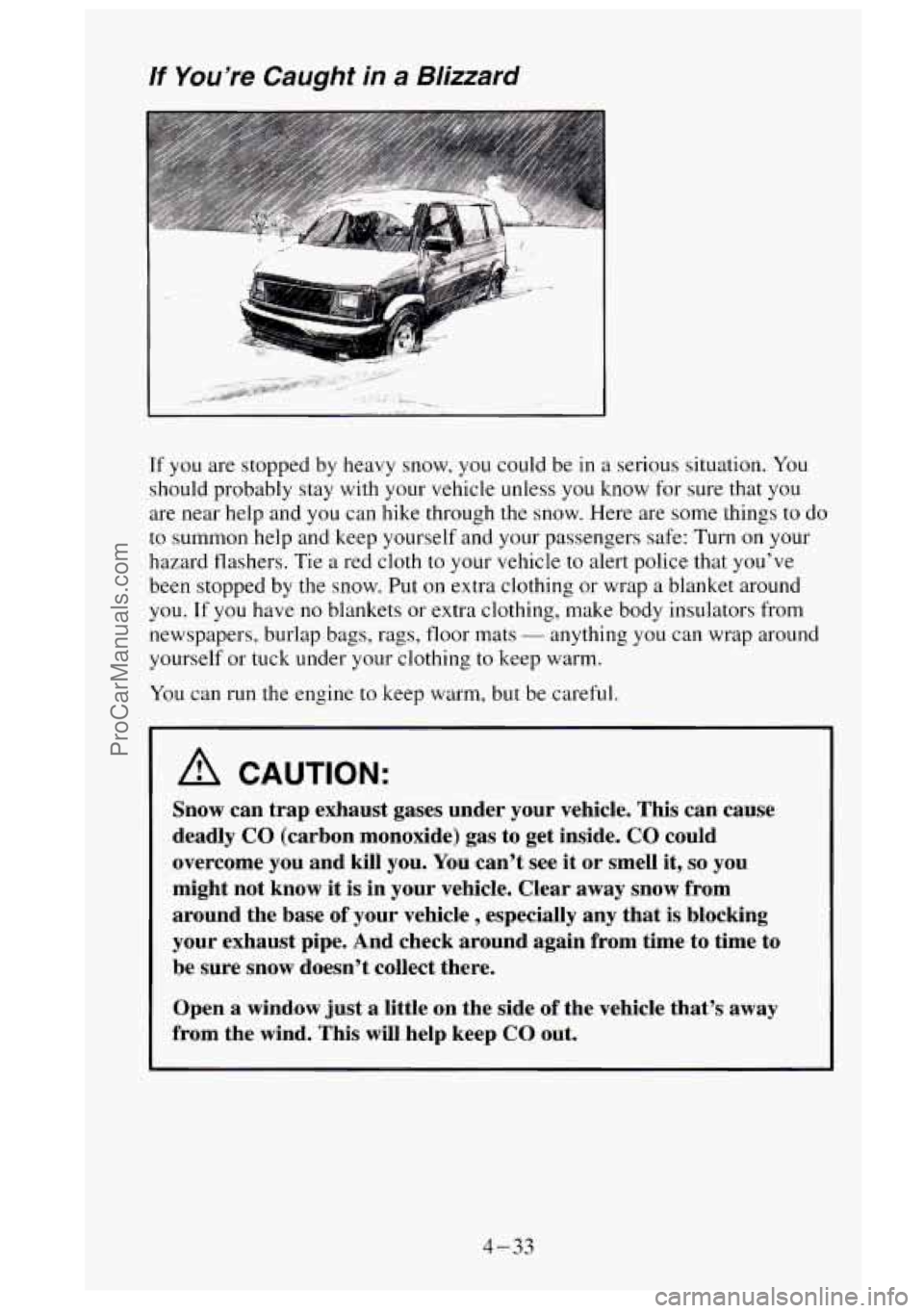
If You’re Caught in a Blizzard
k
I ....- -’
If you are stopped by heavy snow, you could be in a serious situation. You
should probably stay with your vehicle unless you know for sure that you
are near help and
you can hike through the snow. Here are some things to do
to summon help and keep yourself and your passengers safe: Turn on your
hazard flashers. Tie
a red cloth to your vehicle to alert police that you’ve
been stopped by the snow.
Put on extra clothing or wrap a blanket around
you.
If you have no blankets or extra clothing, make body insulators from
newspapers, burlap bags, rags, floor mats
- anything you can wrap around
yourself
or tuck under your clothing to keep warm.
You can run the engine to keep warm, but be careful.
-
A CAUTION:
Snow can trap exhaust gases under your vehicle. This can cause
deadly
CO (carbon monoxide) gas to get inside. CO could
overcome you and kill you.
You can’t see it or smell it, so you
might not know it is in your vehicle. Clear away snow from
around the base of your vehicle
, especially any that is blocking
your exhaust pipe.
And check around again from time to time to
be sure snow doesn’t collect there.
Open a window just
a little on the side of the vehicle that’s away
from the wind. This
will help keep CO out.
4-33
ProCarManuals.com
Page 208 of 488
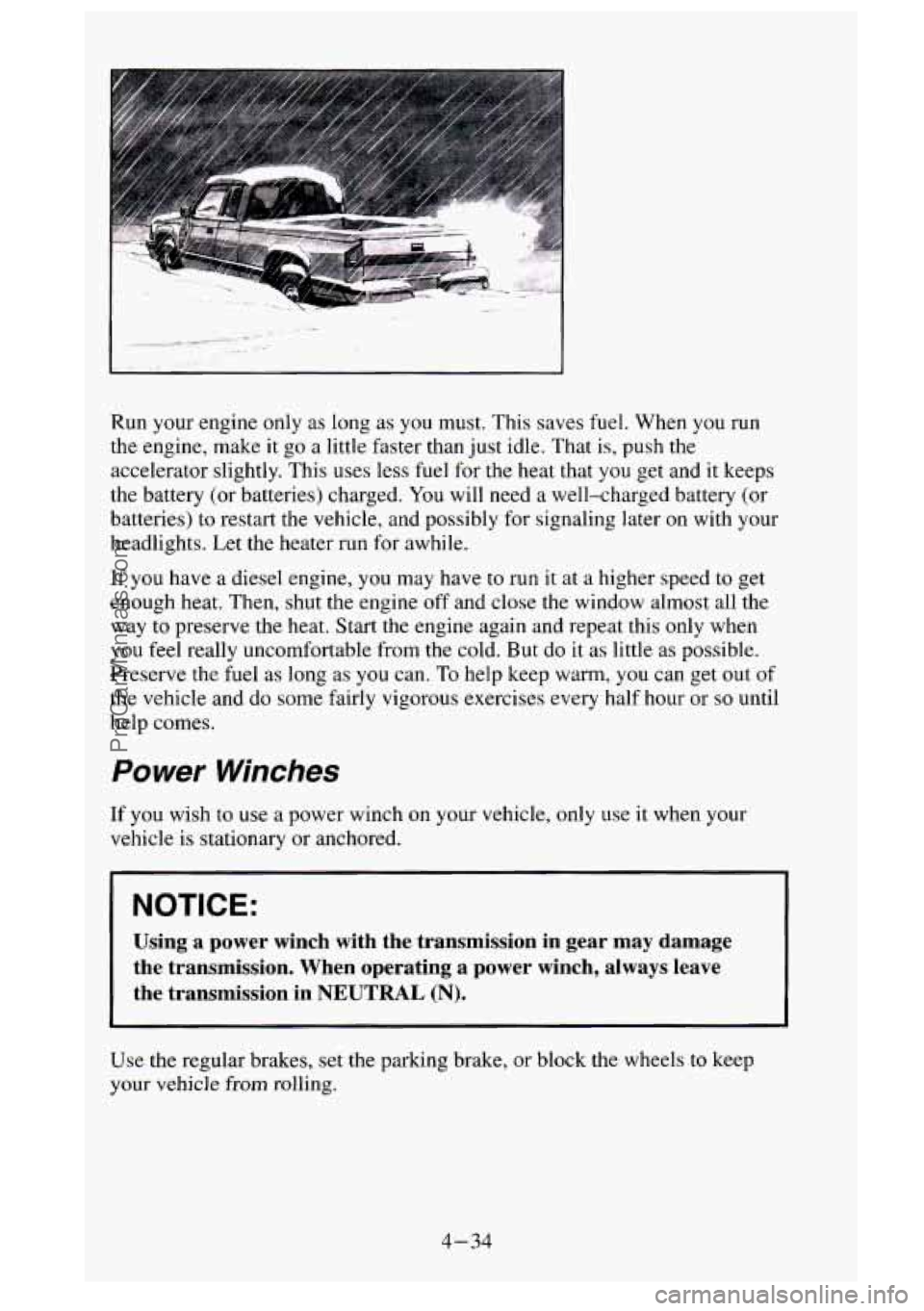
c
Run your engine only as long as you must. This saves fuel. When you run
the engine, make
it go a little faster than just idle. That is, push the
accelerator slightly. This uses less fuel for the heat that
you get and it keeps
the battery (or batteries) charged. You will need a well-charged battery (or
batteries) to restart the vehicle, and possibly for signaling later on with your
headlights. Let the heater run for awhile.
If you have a diesel engine, you may have to run it at a higher speed to get
enough heat. Then, shut the engine off and close the window almost all the
way
to preserve the heat. Start the engine again and repeat this only when
you feel really uncomfortable from the cold. But do it as little as possible.
Preserve the fuel as long
as you can. To help keep warm, you can get out of
the vehicle and do some fairly vigorous exercises every half hour or so until
help comes.
Power Winches
If you wish to use a power winch on your vehicle, only use it when your
vehicle
is stationary or anchored.
NOTICE:
Using a power winch with the transmission in gear may damage
the transmission. When operating a power winch, always leave
the transmission in NEUTRAL
(N).
Use the regular brakes, set the parking brake, or block the wheels to keep
your vehicle
from rolling.
4-34
ProCarManuals.com
Page 235 of 488
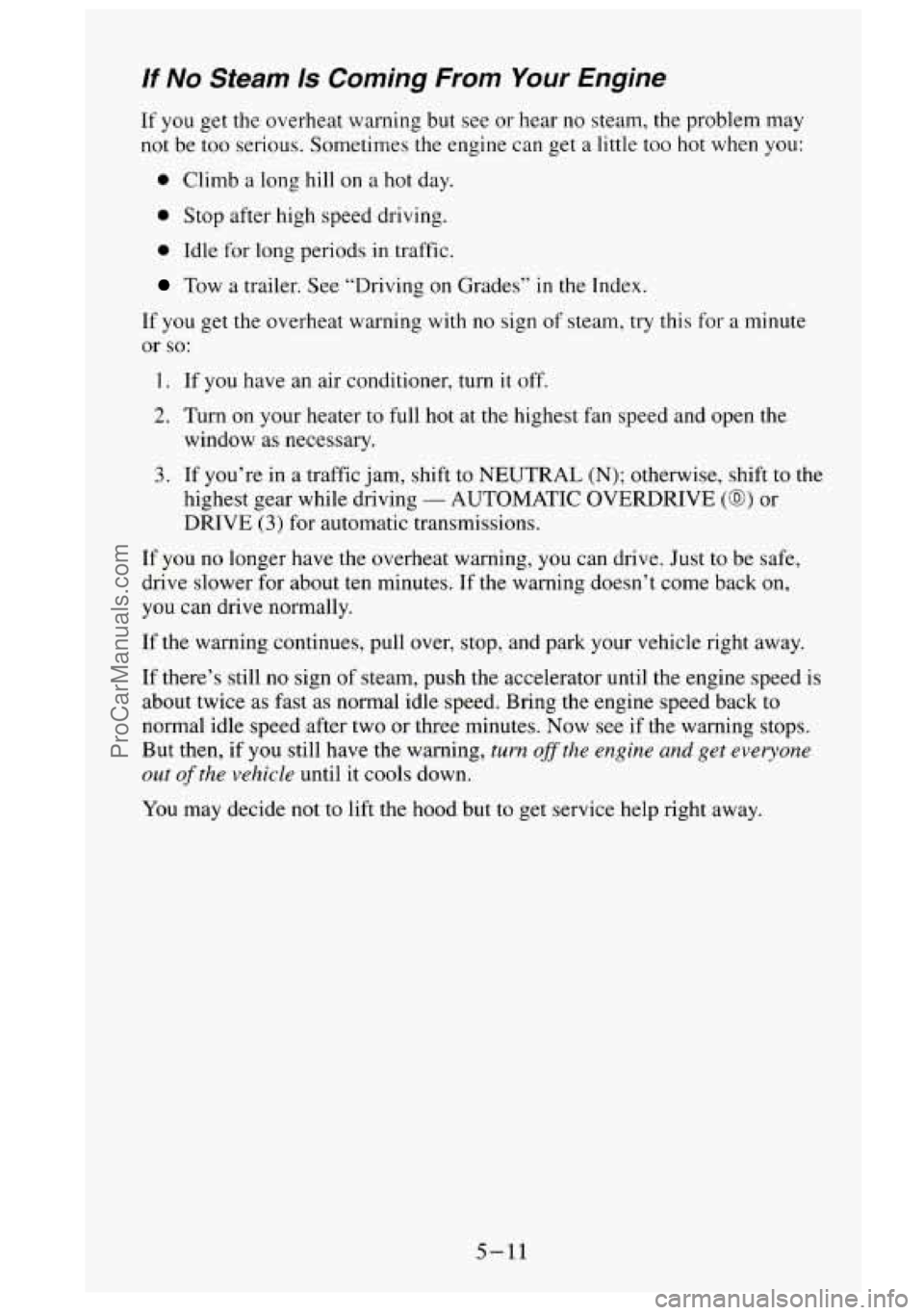
If No Steam Is Coming From Your Engine
If you get the overheat warning but see or hear no steam, the problem may
not be too serious. Sometimes the engine can get a little too hot when you:
0 Climb a long hill on a hot day.
0 Stop after high speed driving.
0 Idle for long periods in traffic.
Tow a trailer. See “Driving on Grades’’ in the Index.
If
you get the overheat warning with no sign of steam, try this for a minute
or
so:
1. If you have an air conditioner, turn it off.
2. Turn on your heater to full hot at the highest fan speed and open the
window as necessary.
3. If you’re in a traffic jam, shift to NEUTRAL (N); otherwise, shift to the
highest gear while driving
- AUTOMATIC OVERDRIVE (@) or
DRIVE
(3) for automatic transmissions.
If you no longer have the overheat warning, you can drive. Just to be safe,
drive slower for about ten minutes. If the warning doesn’t come back on,
you can drive normally.
If
the warning continues, pull over, stop, and park your vehicle right away.
If there’s still no sign of steam, push the accelerator until the engine speed is
about twice as fast as normal idle speed. Bring the engine speed back to
normal idle speed after two or three minutes. Now see
if the warning stops.
But then, if
you still have the warning, turn ofSthe engine and get everyone
out of the vehicle until it cools down.
You may decide not to lift the hood but to get service help right away.
5-11
ProCarManuals.com
Page 309 of 488
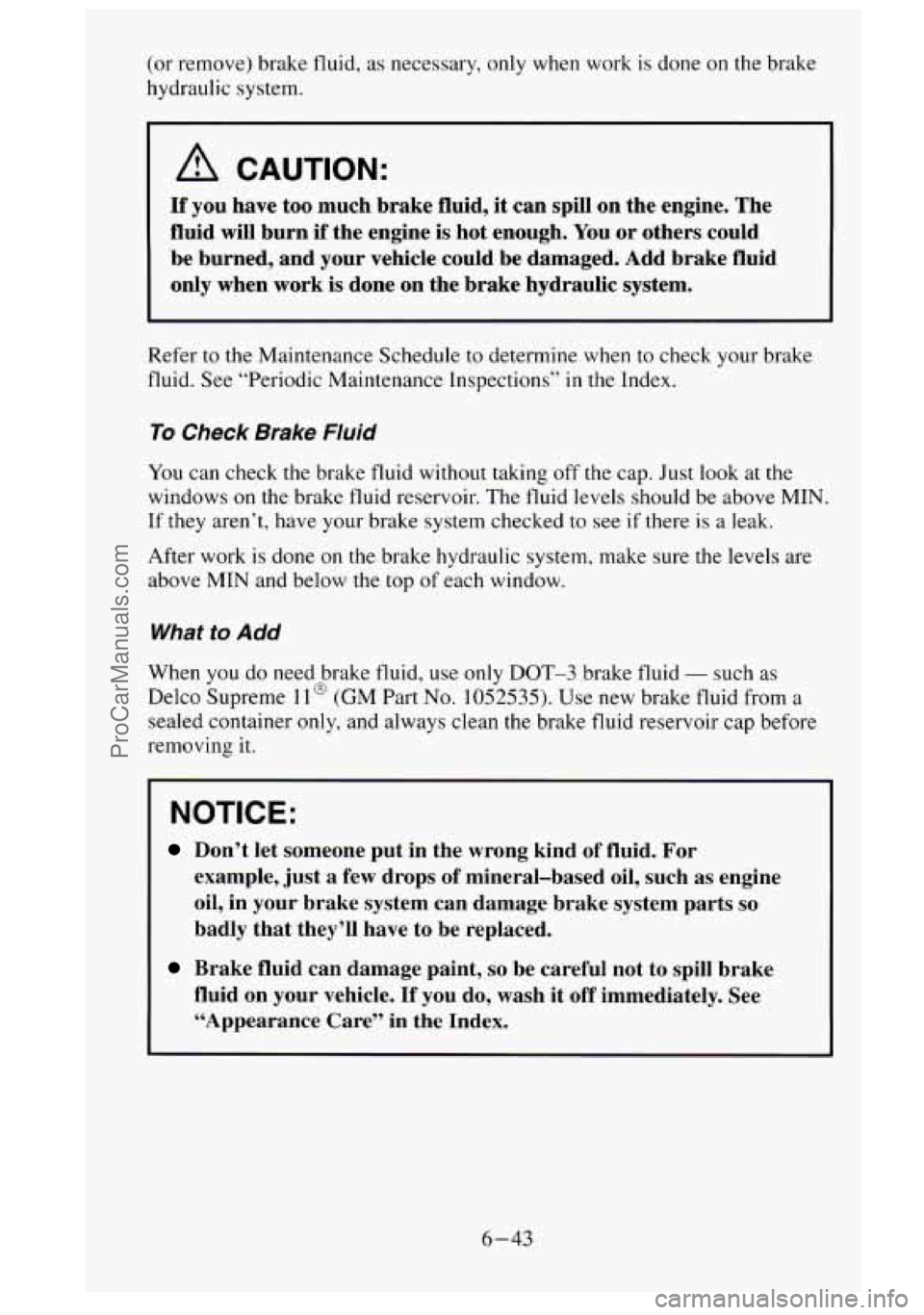
(or remove) brake fluid, as necessary, only when work is done on the brake
hydraulic system.
A CAUTION:
If you have too much brake fluid, it can spill on the engine. The
fluid will burn
if the engine is hot enough. You or others could
be burned, and your vehicle could be damaged. Add brake fluid
only when work is done on the brake hydraulic system.
Refer to the Maintenance Schedule to determine when to check your brake
fluid. See “Periodic Maintenance Inspections”
in the Index.
To Check Brake Fluid
You can check the brake fluid without taking off the cap. Just look at the
windows on the brake fluid reservoir. The fluid levels should be above MIN.
If they aren’t, have your brake system checked to see if there is a leak.
After work
is done on the brake hydraulic system, make sure the levels are
above MIN and below the top
of each window.
What to Add
When you do need brake fluid, use only DOT-3 brake fluid - such as
Delco Supreme 11
@ (GM Part No. 1052535). Use new brake fluid from a
sealed container only, and always clean the brake fluid reservoir cap before
removing it.
NOTICE:
Don’t let someone put in the wrong kind of fluid. For
example, just
a few drops of mineral-based oil, such as engine
oil, in your brake system can damage brake system parts
so
badly that they’ll have to be replaced.
Brake fluid can damage paint, so be careful not to spill brake
fluid on your vehicle.
If you do, wash it off immediately. See
“Appearance Care” in the Index.
6-43
ProCarManuals.com
Page 333 of 488
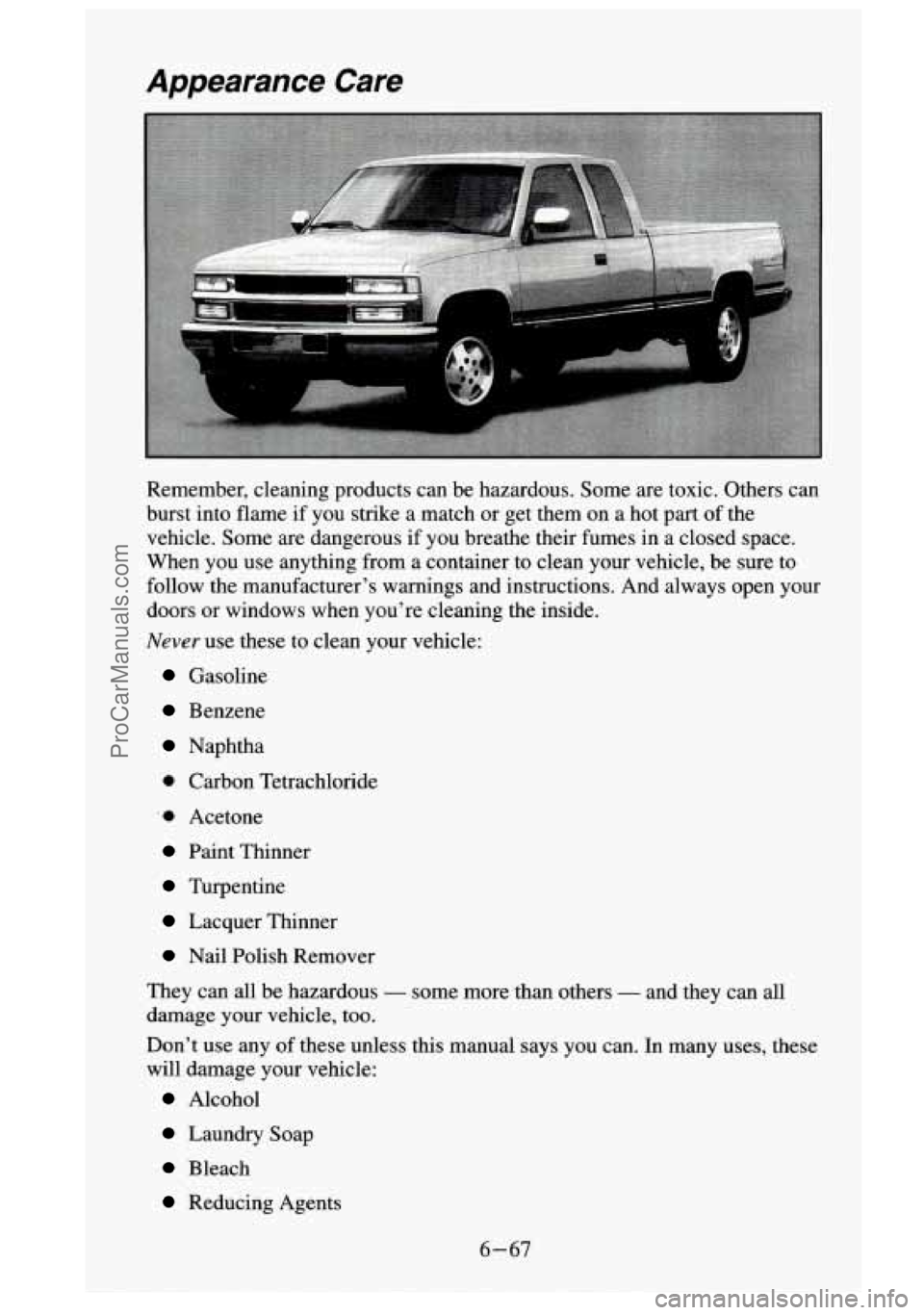
Appearance Care
Remember, cleaning products can be hazardous. Some are toxic. Others can
burst into flame if you strike a match
or get them on a hot part of the
vehicle. Some are dangerous if you breathe their fumes in a closed space.
When you use anything from a container to clean your vehicle, be sure to
follow the manufacturer’s warnings and instructions. And always open your
doors or windows when you’re cleaning the inside.
Never use these to clean your vehicle:
Gasoline
Benzene
Naphtha
0 Carbon Tetrachloride
’0 Acetone
Paint Thinner
Turpentine
Lacquer Thinner
Nail Polish Remover
They can all be hazardous
- some more than others - and they can all
damage your vehicle,
too.
Don’t use any of these unless this manual says you can. In many uses, these
will damage your vehicle:
Alcohol
Laundry Soap
Bleach
Reducing Agents
6-67
ProCarManuals.com